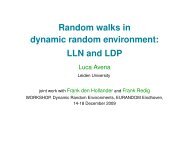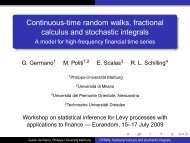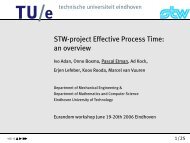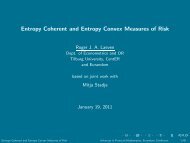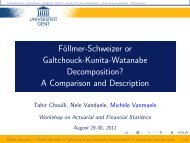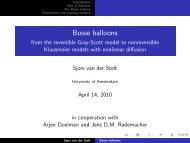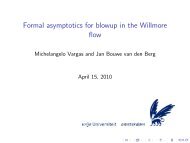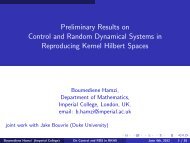EURANDOM
EURANDOM
EURANDOM
You also want an ePaper? Increase the reach of your titles
YUMPU automatically turns print PDFs into web optimized ePapers that Google loves.
Random Spatial Structures (RSS)<br />
Elie Aidekon<br />
In joint work with Remco van der Hofstad and Johan van Leeuwaarden, we are interested in asymptotic<br />
properties of inhomogeneous random graphs. We currently look at the tail distribution of the renormalized<br />
biggest cluster. He is also interested in various problems of branching random walks on the<br />
real line, which are related to the solutions of the F-KPP equation.<br />
Dimitris Cheliotis<br />
In a visit to Toronto from December 16 until January 10, I worked on a joint project I have with Balint<br />
Virag (Associate Professor at the University of Toronto) that proves a functional law of the iterated<br />
logarithm for Sinai's walk and related diffusions. The major part of the work was finished,<br />
and in the months since then, I fixed some problems that surfaced after a careful reading.<br />
The paper will be submitted after my co-author reads it in its current form, I expect by the end of<br />
the year.<br />
In February and March, I resumed a project I left for one year. It concerns the metastable states for<br />
Sinai's walk. I consider the consecutive well depths that give rise to metastable states of increasing<br />
stability, and I obtained an explicit description of this process.<br />
My next target is to prove a large deviations principle for the number of metastable states visited<br />
at a given large time interval. From the first part of the work, I have a candidate rate function, but<br />
this proof needs more work.<br />
I expect to finish this within the coming academic year.<br />
I continued working with Frank den Hollander on the pinning problem for directed polymers. The<br />
main issue is to study the influence of disorder in the critical phase of a polymer pinned in an interface,<br />
and there is a widely known conjecture for it. Last year we were able to cover a large class of<br />
polymers where disorder had no influence. Now we extended our results to a more general setting,<br />
but there is still work needed to completely solve the problem.<br />
This project is my first priority for the following months.<br />
Sander Dommers<br />
Sander Dommers has, together with Remco van der Hofstad (TU/e and <strong>EURANDOM</strong>) and Gerard Hooghiemstra<br />
(TU Delft), investigated distances in preferential attachment models. They gave bounds on<br />
both typical distances in and the diameters of such random graphs.<br />
Furthermore, he studied the Ising model on the configuration model together with Cristian Giardina<br />
(TU/e and <strong>EURANDOM</strong>) and Remco van der Hofstad. They generalized a result of Dembo and Montanari,<br />
giving an explicit formula for the thermodynamic limit of the pressure, also when the degree sequence<br />
has an infinite variance, but finite mean.<br />
Robert Fitzner<br />
In the last months we identified the eigensystem of a transition matrix for memory two walk.<br />
Moreover we derived an extended version of the lace expansion equation, for the self-avoiding walk<br />
and percolation. This results in a matrix-valued lace expansion equation.<br />
Right now we evaluate ways to analyze this matrix-valued equation to perform the lace expansion<br />
analysis, where we will also need to identify all lace expansion coefficients that we need to compute.<br />
In this process we will establish, what the necessary conditions on the lace expansion coefficients are.<br />
Then we will derive sharp bounds on the coefficients.<br />
Thereby we will first complete the work on the self-avoiding walks to reprove the result that selfavoiding<br />
walks display mean-field behavior above dimension 4. Having done this we will try to show<br />
that nearest-neighbor percolation above 6 dimensions also displays mean-field behavior.<br />
Tim Hulshof<br />
We investigate random walks on the incipient infinite cluster for high dimensional percolation models.<br />
Specifically our attention is aimed towards gaining a better understanding of the behavior of longrange<br />
spread-out percolation models. For instance, several noticeable differences between the volume<br />
and effective resistance of long- and finite range percolation clusters become noticeable when random<br />
walks on clusters are analyzed in the Euclidean distance metric, as opposed to the graph distance metric.<br />
<strong>EURANDOM</strong> Annual Report 2009 12



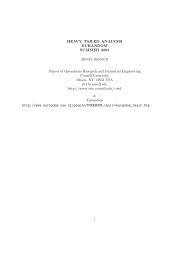
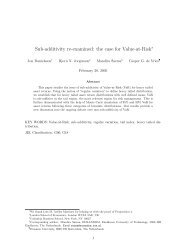
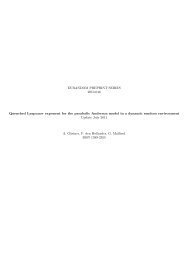
![The Contraction Method on C([0,1]) and Donsker's ... - Eurandom](https://img.yumpu.com/19554492/1/190x143/the-contraction-method-on-c01-and-donskers-eurandom.jpg?quality=85)
